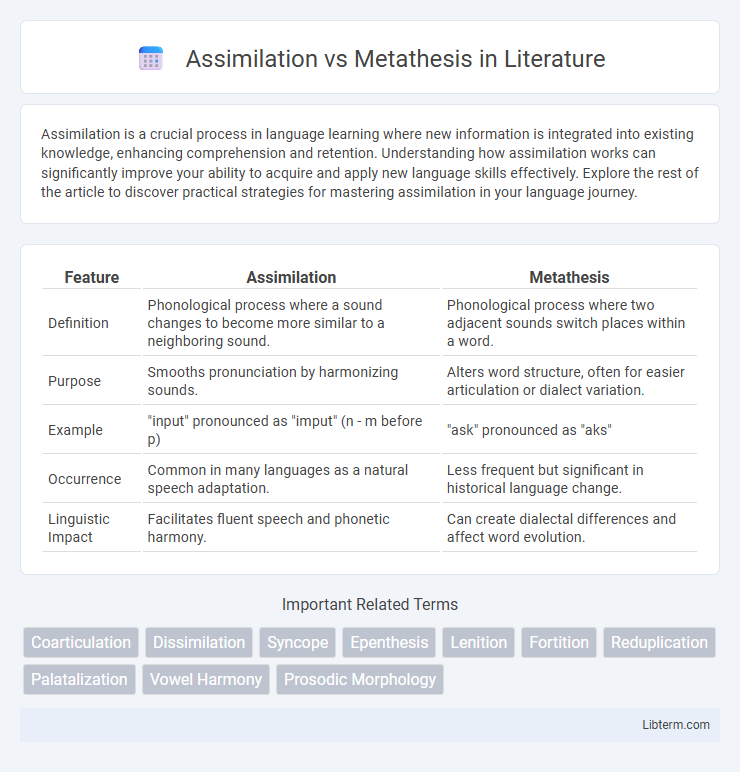Assimilation is a crucial process in language learning where new information is integrated into existing knowledge, enhancing comprehension and retention. Understanding how assimilation works can significantly improve your ability to acquire and apply new language skills effectively. Explore the rest of the article to discover practical strategies for mastering assimilation in your language journey.
Table of Comparison
| Feature | Assimilation | Metathesis |
|---|---|---|
| Definition | Phonological process where a sound changes to become more similar to a neighboring sound. | Phonological process where two adjacent sounds switch places within a word. |
| Purpose | Smooths pronunciation by harmonizing sounds. | Alters word structure, often for easier articulation or dialect variation. |
| Example | "input" pronounced as "imput" (n - m before p) | "ask" pronounced as "aks" |
| Occurrence | Common in many languages as a natural speech adaptation. | Less frequent but significant in historical language change. |
| Linguistic Impact | Facilitates fluent speech and phonetic harmony. | Can create dialectal differences and affect word evolution. |
Understanding Assimilation and Metathesis
Assimilation refers to the phonological process where a sound becomes more like a neighboring sound in terms of features such as place, manner, or voicing, enhancing speech fluidity and efficiency. Metathesis involves the reordering of sounds or syllables within a word, often occurring in language evolution or dialectal variation to simplify articulation or improve auditory clarity. Understanding assimilation and metathesis provides insight into natural language change mechanisms and phonetic adaptation strategies.
Key Differences Between Assimilation and Metathesis
Assimilation involves the process where one sound becomes similar to a neighboring sound, typically to ease pronunciation, such as the nasal sound in "input" becoming "imput." Metathesis refers to the transposition of sounds or syllables within a word, altering the original sequence, as seen in the historical change from "ask" to "aks." Key differences lie in assimilation's focus on sound similarity for phonetic harmony, while metathesis involves reordering sounds without necessarily creating similarity.
The Role of Assimilation in Language Change
Assimilation plays a crucial role in language change by simplifying complex sound sequences to enhance ease of pronunciation and speech fluency, often causing adjacent phonemes to become more similar. This phonological process drives linguistic evolution by gradually altering word forms across generations, influencing dialect formation and the emergence of new phonetic patterns. Unlike metathesis, which involves the rearrangement of sounds, assimilation systematically modifies phoneme identity based on neighboring sounds, thereby shaping the phonological structure of languages over time.
Types of Assimilation in Linguistics
Assimilation in linguistics refers to the process where a sound becomes similar to a neighboring sound, which improves phonetic flow. Types of assimilation include progressive assimilation, where a sound influences the following sound; regressive assimilation, where a following sound influences the preceding sound; and reciprocal assimilation, where two sounds influence each other simultaneously. These processes can be further categorized as complete, partial, or coalescent assimilation based on the degree of sound change.
Metathesis: Definition and Linguistic Examples
Metathesis is a phonological process in which two adjacent sounds within a word switch places, altering the word's pronunciation or structure. This phenomenon occurs in various languages, exemplified by the Old English word "brid" evolving into "bird" in Modern English and the Latin word "miraculum" shifting to "miracle" in English. Linguistic studies show metathesis can impact lexical development and phonotactic constraints, distinguishing it from assimilation, where sounds become more similar to neighboring sounds.
Historical Cases of Metathesis in Languages
Historical cases of metathesis reveal significant sound changes across diverse languages, such as the Old English "brid" evolving into modern "bird" and Latin "miraculum" transforming into Spanish "milagro." These phonological shifts reorganize the order of sounds within words, contrasting with assimilation, which involves the modification of sounds to become more similar to neighboring phonemes. Metathesis demonstrates the dynamic nature of language evolution, shaping pronunciation patterns and morphological development over time.
Phonological Processes: How Assimilation and Metathesis Operate
Assimilation and metathesis are key phonological processes that alter speech sounds to enhance linguistic efficiency and clarity. Assimilation involves a sound change where one phoneme becomes similar or identical to a neighboring sound, facilitating smoother articulation; for example, the nasalization in "input" pronounced as "imput." Metathesis, by contrast, rearranges the order of sounds or syllables within a word, as observed in "ask" pronounced as "aks," reflecting variations in dialects and historical sound changes.
Factors Influencing Assimilation and Metathesis
Factors influencing assimilation include the phonetic environment, speech rate, and the speaker's dialect, which affect how sounds become more alike to ease articulation. Metathesis is shaped by factors such as linguistic economy, ease of pronunciation, and historical language changes, leading to sound reordering within words. Both processes are driven by efforts to optimize speech fluency and clarity, interacting with cognitive and social language dynamics.
Impact on Language Evolution and Pronunciation
Assimilation influences language evolution by simplifying pronunciation through the gradual adjustment of sounds to neighboring phonemes, enhancing speech fluidity and intelligibility. Metathesis impacts language by rearranging phoneme sequences, sometimes leading to the formation of new word forms and dialectal variations over time. Together, these phonological processes shape linguistic change by affecting both historical language development and contemporary speech patterns.
Comparing the Significance of Assimilation vs Metathesis
Assimilation enhances phonetic harmony by modifying sounds to become more similar to adjacent phonemes, improving speech fluidity and listener comprehension. Metathesis involves the reordering of sounds within a word, often caused by historical language evolution or speech errors, which can affect word clarity but also enrich linguistic diversity. Comparing assimilation and metathesis highlights that assimilation primarily serves phonological cohesion, while metathesis contributes to diachronic language change and morphological variation.
Assimilation Infographic

 libterm.com
libterm.com